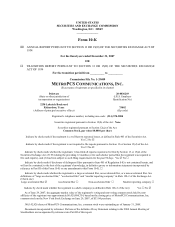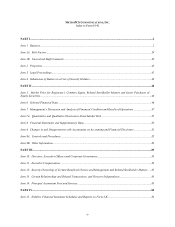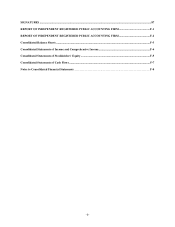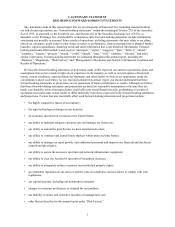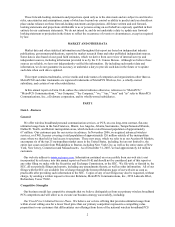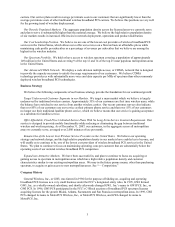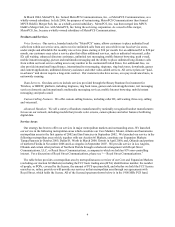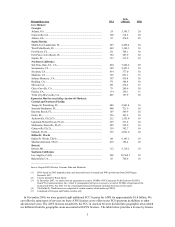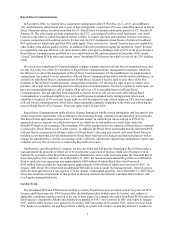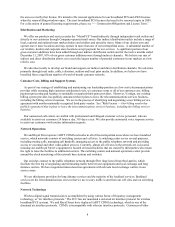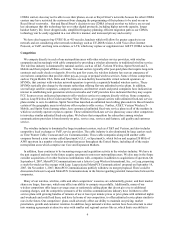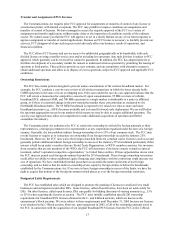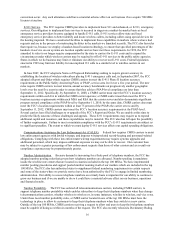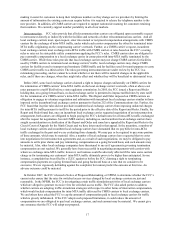Metro PCS 2007 Annual Report Download - page 19
Download and view the complete annual report
Please find page 19 of the 2007 Metro PCS annual report below. You can navigate through the pages in the report by either clicking on the pages listed below, or by using the keyword search tool below to find specific information within the annual report.8
the area covered by that license. We intend to file renewal applications for our broadband PCS and AWS licenses
when the renewal filing windows open. The next broadband PCS licenses that need to be renewed expire in 2009.
For a discussion of general licensing requirements, please see “— Construction Obligations and License Term.”
Distribution and Marketing
We offer our products and services under the “MetroPCS” brand indirectly through independent retail outlets and
directly to our customers through Company-operated retail stores. Our indirect distribution outlets include a range of
local, regional and national mass market dealers and retailers and specialty stores. Many of our dealers own and
operate one or more locations and may operate in more than one of our metropolitan areas. A substantial number of
our retailers, dealers and corporate store locations accept payment for our services. A significant portion of our
gross customer additions have been added through our indirect distribution outlets and for the twelve months ended
December 31, 2007, 85% of our gross customer additions were through indirect channels. We believe our mix of
indirect and direct distribution allows us to reach the largest number of potential customers in our markets at a low
relative cost.
We advertise locally to develop our brand and support our indirect and direct distribution channels. We advertise
primarily through local radio, cable, television, outdoor and local print media. In addition, we believe we have
benefited from a significant number of word-of-mouth customer referrals.
Customer Care, Billing and Support Systems
As part of our strategy of establishing and maintaining our leadership position as a low cost telecommunications
provider while ensuring high customer satisfaction levels, we outsource some or all of our customer care, billing,
payment processing and logistics to nationally recognized third-party providers. However, Verisign, our existing
billing system provider, has publicly announced that it plans to leave the telecommunications services business,
including the billing services business. We are in the process of identifying and negotiating a new billing service
agreement with another nationally recognized third party vendor. See “Risk Factors — Our billing vendor has
publicly announced that it plans to leave the telecommunications services business, including the billing services
business.”
Our outsourced call centers are staffed with professional and bilingual customer service personnel, who are
available to assist our customers 24 hours a day, 365 days a year. We also provide automated voice response service
to assist our customers with routine information requests.
Network Operations
We and Royal Street operate 1xRTT CDMA networks in all of the metropolitan areas where we have launched
service, which networks consists of switching centers and cell sites. A switching center serves several purposes,
including routing calls, managing call handoffs, managing access to the public telephone network and providing
access to voicemail and other value-added services. Currently, almost all cell sites in the network are co-located,
meaning our and Royal Street’ s equipment is located on leased facilities that are owned by third parties who retain
the right to lease the facilities to additional carriers. The switching centers and national operations center provide
around-the-clock monitoring of the network base stations and switches.
Our switches connect to the public telephone network through fiber rings leased from third-parties, which
facilitate the first leg of originating and terminating traffic between our equipment and local exchange and long
distance carriers. We have negotiated interconnection agreements with relevant local exchange carriers in our
service areas.
We use third-party providers for long distance services and the majority of the backhaul services. Backhaul
services are the telecommunications services that we use to carry traffic to and from our cell sites and our switching
facilities.
Network Technology
Wireless digital signal transmission is accomplished by using various forms of frequency management
technology, or “air interface protocols.” The FCC has not mandated a universal air interface protocol for wireless
broadband PCS systems. We and Royal Street have deployed 1xRTT CDMA technology, which is one of the
dominant air interface protocols. CDMA is incompatible with other air interface protocols. Customers of other


